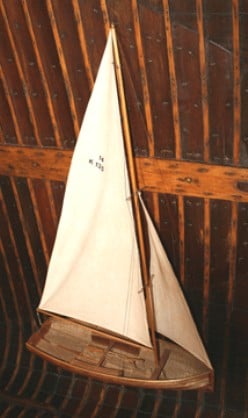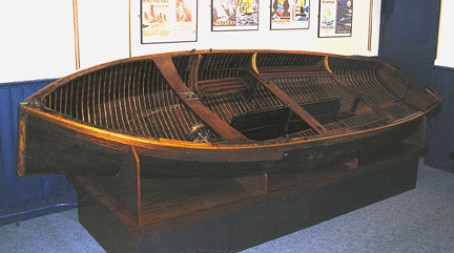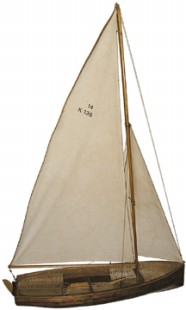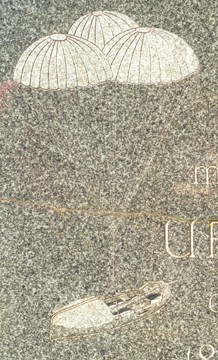Cowes Maritime Museum
Uffa Fox (1898–1972)
_____________________________________________________________________________
Uffa Fox was born on 15 January 1898 at East Cowes. He grew up on the waterfront and was
educated at the nearby village school of Whippingham.
_____________________________________________________________________________
Uffa Fox was born on 15 January 1898 at East Cowes. He grew up on the waterfront and was
educated at the nearby village school of Whippingham.
_____________________________________________________________________________
 This model of Avenger that can be seen at Cowes Maritime Museum. | When aged fourteen Uffa became an apprentice with local boat builders S. E. Saunders. He studied naval architecture and mathematics at evening school. Uffa’s apprenticeship lasted seven years covering boatbuilding, shipbuilding and design. During the First World War he served in the Royal Naval Air Service for nearly two years. At the age of 21 he set up his own boat building business. He acquired an old ‘floating bridge’ that had linked Cowes to East Cowes and roofed over the central part to provide a workshop. The passenger accommodation was converted to a drawing office and living space. |
| Uffa's first major successes as a designer were in the National 14 racing dinghy class. In Cowes Week 1925 Ariel, his first design, won every race in her class. Rodicut, his second design, achieved second in the race for the Prince of Wales cup in 1927.  Avenger can be seen at Cowes Maritime Museum. Uffa was the father of the planing dinghy*. In 1927 he designed and built Avenger, which was far ahead of her time. With the deep V-shaped hull for the first third of her length he introduced a new feature into such boats, which greatly increased their speed. Not only was Avenger a race winner but she was so seaworthy that Uffa sailed her across the Channel to Le Havre in stormy conditions – a trip that took 27 hours. He then raced against the French (and won) and sailed home again. Avenger was radical because she was the first true planing dinghy that also had a good performance to windward. Very little could touch her. In 1928 she made 57 starts and won 52, including the Prince of Wales Cup. *A boat which is planing is skimming along the surface, rising up on its own bow wave, which results in less friction against the water. The power given by the sails has to overcome less resistance, and therefore speed increases dramatically beyond the usual speed limits for a small sailing boat. |
  Airborne Lifeboat | All of Uffa’s triumphs were greatly assisted by the fact that he was himself a first-class helmsman. Following the success of the Fourteens he applied the concept to other classes. He used his experience with these dinghies to design and build a sailing canoe. He won both the American championship for paddling and sailing and the New York International Canoe Championship in 1933. Prior to the Second World War Uffa had established his name primarily in the world of dinghies; his designs dominated the National Twelves, Fourteens and Eighteens. During the Second World War Uffa conceived the idea of the first parachuted Airborne Lifeboat. This vessel was carried beneath aeroplanes and dropped by parachute to survivors of ditched aircraft. The Airbornes had sails, engine, survival kit and instructions on how to sail them. Many aircrews owed their lives to Uffa’s invention. For all his success in the field of yacht racing he maintained that this was his most fulfilling design. |
Immediately after the war he was closely associated with Fairey Marine of Hamble who
built hot moulded boats to his design.
His 12-foot Firefly won the Royal Yachting Association design competition and was
selected as a class for the 1948 Olympics. He then turned his attention to the creation
of the Flying Fifteen, a successful boat with which he achieved all his ambitions. The
town of Cowes presented Coweslip, a Flying Fifteen, to Prince Philip, Duke of Edinburgh,
who sailed her with Uffa, as did Prince Charles. Coweslip can be seen at the Classic Boat
Museum.
In 1968 Uffa designed the 22-foot Atlantic rowboat Britannia, in which John Fairfax
rowed across the Atlantic.
Throughout his life he wrote a considerable number of articles, and published some ten
books on maritime matters. He recorded rendering of various sea shanties, and was a
Scout Master with the Cowes Sea Scouts. He was appointed a royal designer for industry
in 1955 and made a CBE in 1959.

Road sign in Cowes.
Uffa Fox died on 26 October 1972 at Alvechurch, Worcestershire. His great friend
Sir Max Aitken read the lesson for the funeral service at the packed Holy Trinity
Church at Cowes.
_____________________________________________________________________________
Page last updated on: 28/07/2011





